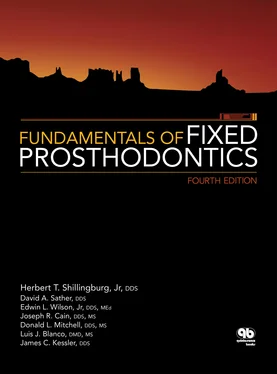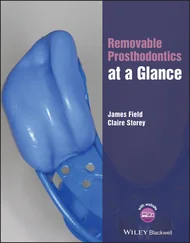The mounting stone will engage undercuts in the mounting plate and cast. Additional stone can be added if needed to secure the mounting. When the stone has set completely, the transfer jig is removed from the articulator. The incisal guide block is replaced in the articulator. The transfer jig is then rinsed with a hospital-grade disinfectant and stored until ready to be used again. All registration material is removed from the bite fork, which is then placed in a sealed sterilization bag and submitted for steam sterilization.
Mounting the mandibular cast
The incisal pin is adjusted for a 2-mm opening to accommodate the thickness of the interocclusal record. The articulator with the attached maxillary cast is inverted, with care taken to ensure that the centric latch is engaged. The centric relation interocclusal wax record is placed on the maxillary cast. The teeth should seat completely into the record.
The mandibular cast is placed into the interocclusal record, with care taken to ensure that the teeth are fully seated. There should be no contact between the maxillary and mandibular casts. The mandibular cast is removed, and the bottom and sides of it are soaked in a partially filled bowl of water for about 2 minutes.
The soaked mandibular cast is reseated into the interocclusal wax record. Some mounting stone is mixed to a thick, creamy consistency, and a mound of it is placed on the inverted bottom of the cast. Some mounting stone is applied to the mounting plate on the lower member of the articulator, which is hinged down into the soft stone on the cast until the incisal guide pin makes firm contact with the incisal guide block. The mandibular cast is stabilized by hand to keep it securely in the interocclusal record until the mounting stone sets ( Fig 5-48). Rubber bands or sticky wax can also be used, but they are more likely to slip and produce a mounting error.

Fig 5-48The cast is held in the interocclusal wax record until the mounting stone sets.
The casts and articulator are examined for the following:
The condyle is located against the posterior and superior walls of the condylar guide.
Both casts are completely seated in the interocclusal record.
Mounting stone engages undercuts on both the base of the cast and the mounting plate.
When the mounting stone has set completely, the accuracy of the mounting is confirmed. The articulator is opened, the interocclusal record is removed, and the incisal guide pins are raised 1 inch. A 2-inch piece of no. 10 red-inked silk ribbon is placed between the posterior teeth on both sides. The teeth are tapped together lightly with the condyles against the posterior wall of the condylar guide, leaving red dots that represent the contacts at centric relation position, as described in chapter 4.
The pieces of 28-gauge green wax that have been stored in a cup are retrieved and lightly placed on the teeth of the maxillary cast. The accuracy of the mounting is confirmed if the red dots are visible through the perforations in the wax. If they are not visible, the procedure should be rechecked and the error corrected.
The casts and their mounting plates are removed from the articulator. Additional mounting stone is mixed to fill any voids between the casts and their mounting plates. The mounting stone is smoothed with a finger to give it a neat appearance. No stone should remain on the surface of the mounting plate that will contact the articulator frame. Both the dental technician and the patient form an impression of the dentist when they see these casts on the articulator, so it is important to make sure that it is a positive one.
Setting condylar guidance
A hex driver is used to loosen the set screw on the underside of each fossa, and the medial side wall is set to a 6-degree progressive lateral translation. The lock screw on each end of the posterior aspect of the upper crossbar of the articulator is released using a hex driver, and both condylar guides are set at 0 degrees. Then the set screw is loosened on the top of each fossa as far as possible to the medial. The incisal guide pin is lifted to prevent it from touching the plastic incisal stop in any position. The centric latch is released.
The right lateral interocclusal record is seated on the maxillary cast attached to the inverted upper member of the articulator. The teeth should seat completely in the wax indentations. The upper member of the articulator is held in the left hand, and the right condylar element is placed in the right condylar guide. The teeth of the mandibular cast are seated gently but completely into the indentations of the wax record.
One hand is used on the right side of the articulator to support it in this position. The left condylar element will have moved downward, forward, and inward. It should not be touching the condylar guide at any point ( Fig 5-49).
The inclination of the right protrusive condylar path is increased by rotating the fossa until the superior wall makes contact with the condylar element ( Fig 5-50a). The set screw on the back of the upper crossbar is tightened with a hex driver. The immediate lateral translation is set by moving the medial wall of the fossa outward or laterally until it contacts the medial surface of the condylar element ( Fig 5-50b). The set screw is retightened. The wax interocclusal record for the left lateral excursion is used to set the right condylar guidance in the same manner.

Fig 5-49The right lateral interocclusal record causes the left condyle to move away from the superior wall (a) and the medial wall (b) of the guide.

Fig 5-50To adjust the condylar guide, the condylar inclination is increased until the superior wall contacts the condyle (a) , and the medial wall is moved into contact with the condyle (b) .
After the articulator is set, the data is recorded on the patient’s information card. The articulator settings for each side are marked on the respective side of the patient’s cast. For example, a condylar inclination of 35 degrees and an immediate lateral translation of 0.6 mm would be recorded as 35/0.6. When teeth are prepared at a future time, working casts can be mounted on the articulator without making new records. The instrument can be reset using the recorded information from the diagnostic mounting.
The mounted casts are examined on the articulator. Any nonworking interferences are removed from the casts so that the articulator can move freely while the anterior teeth remain in contact. If the guidance is inadequate for any reason, it is restored to an optimum configuration with a diagnostic wax-up.
The incisal guide pin is raised so that it will be at least 1 mm off the plastic incisal guide block in all excursions ( Fig 5-51). Acrylic resin or a light-cured material (Triad) may be used. If a resin is used, the surface of the guide block is moistened with monomer. A half scoop of tray resin is mixed, and, while it is still free-flowing, a small amount is placed on the incisal guide. As the polymerizing resin becomes stiffer, more is added until there is about ¼ inch of it covering the guide block ( Fig 5-52). The end of the incisal guide pin and all contacting surfaces of the anterior teeth are lubricated with petrolatum. The articulator is closed so that the teeth occlude completely. The guide pin will penetrate the soft acrylic resin ( Fig 5-53). The articulator is moved through all excursions repeatedly, keeping the teeth contacting at all times ( Fig 5-54). The tip of the guide pin will mold the acrylic resin to record the pathway of the various movements. The movements are continued until the resin is completely polymerized. The excess is trimmed off. A record of the anterior guidance has been formed on the incisal table ( Fig 5-55).
Читать дальше















